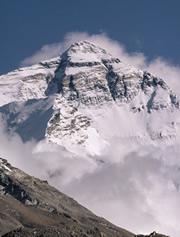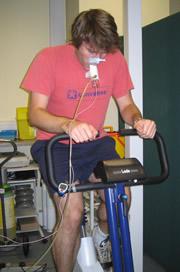 Exercise bikes on Everest: researchers aim to test blood oxygen levels from base camp to peak.Punchstock
Exercise bikes on Everest: researchers aim to test blood oxygen levels from base camp to peak.PunchstockFor most people who attempt to climb Mount Everest, getting to the top is achievement enough. But an intrepid band of British medical researchers aims to go one better. They plan to study the effects of altitude on their own bodies by conducting physical tests on the roof of the world.
The expedition, scheduled for the spring of 2007, is the culmination of a project called Xtreme Everest, spearheaded by doctors who specialize in anaesthesia and intensive care. By pushing their own bodies to the limit, they hope to gain insights into how both altitude and the stresses of critical illness affect the body.
One effect of altitude is to decrease blood oxygen saturation, reducing the effectiveness of breathing at distributing oxygen around the body. Levels are thought to drop to as little as 70% at high altitude, compared with around 97% at sea level.
To help counter such effects, climbers spend time at gradually increasing altitudes to grow accustomed to the thinner air. "If you reached the top of Everest without acclimatizing you would be unconscious within two minutes, and death would follow rapidly," says team leader Mike Grocott of the Centre for Aviation, Space and Extreme Environment Medicine (CASE) at University College London, UK.
But everyone is affected differently, often with little relation to their apparent fitness at sea level. "A person who had done lots of training might storm up a mountain thinking they can do it, and then really suffer," says Rebecca Forth, who is carrying out related experiments for the team at University College London's Human Performance Laboratory (in an effort called Project Everest).
Through lab tests with volunteers, alongside field measurements of the Everest team, the group aims to assess the natural range of variation in people's ability to acclimatize, and to work out why some are better at it than others.
Fit for heights
 Intrepid reporter Michael Hopkin hops on a bike to test his altitude skills (
Intrepid reporter Michael Hopkin hops on a bike to test his altitude skills (There are known to be genetic differences in Tibetan and Andean populations that seem to help them adapt to altitude. Forth and her colleagues suspect that genes play an important role within population groups too.
Different versions of a gene called ACE are known to contribute to whether people have a natural talent for explosive, powerful events such as weightlifting, or long-distance endurance events. Similar variations may underpin people's different rates of acclimatization.
To investigate, Forth is putting male volunteers through exercise tests in a lab-based study that provides air conditions similar to those at the top of Everest, and investigating their genetics (for an account of how your reporter fared when he took the test, see 'So could I climb Everest?').
Field trip
Forth will not be travelling to Everest, because as captain of Britain's 'ultimate frisbee' team she has prior commitments.
But the rest of the Xtreme team, along with more than 200 volunteers, will be taking exercise bikes up to Everest Base Camp, more than 5,000 metres up. A smaller, ten-strong summit team plans to take steppers, similar to those found in an aerobics class, all the way to the top, at 8,850 metres. They will take blood samples at the peak. "Our goal is to study life at the very limit," says Grocott. Such plans are ambitious - many climbers are reduced to resting between every step when near Everest's top.
The team has just attacked the world's sixth-highest mountain, Cho Oyu in the Himalayas, on a practice expedition. "You don't want to just rock up and be using the equipment for the first time ever," says Jim Pate, who will be running one of the mobile support labs.
ADVERTISEMENT
The group hopes that as a side benefit they may also gain some insight into the stresses placed on the body by severe illness. Blood oxygen levels on Everest's peak can be similar to those of lung-damaged patients on breathing machines, Grocott notes. If nothing else, the experience may give them more empathy for such patients.
The experiment won't be without risk: Everest has claimed the lives of many climbers. Pate stresses that they will be careful not to put ambition at the top of their priorities. "Safety will be first," he says, "and the science will be secondary to safety. Third will be for them to achieve the summit."
Visit our aimhighforaltitude.html">newsblog to read and post comments about this story.
